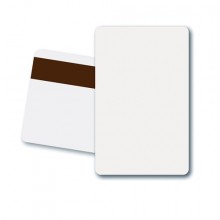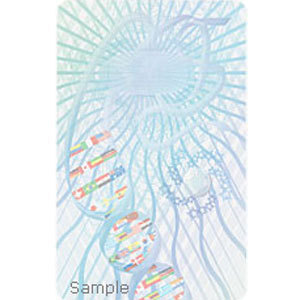Have you ever noticed that some PVC Cards are thinner than others? No they don’t hit the gym more often – they are just a variation of PVC card stock that is used for different purposes in the ID industry. Thin PVC cards are typically only 10 mil, or 0.010″ thick.
Use Cases:
In one example, thin PVC cards are used to produce professional business cards. Doing so will produce a card that is more durable than its ordinary paper counterpart. Designed properly, it will include high-quality imagery, including photo quality logos and even a personal photograph. Not only do these PVC cards hold up better – a PVC business card will help you stand out from the pack!
Thin PVC Cards that are also adhesive-backed are commonly used with proximity-access cards, such as the HID Prox II Clamshell. Clamshell-style cards are too large and thick for standard ID-card printers. Instead, print first on a thin PVC card, and then affix it to the thicker technology card. Not only does this allow for reuse of expensive proximity access cards, but it allows them to double as photo-ID cards!
Usage Notes:
Our adhesive-backed thin PVC cards can be printed with most any direct-to-card printer, and are just slightly smaller than standard CR80 PVC cards. This smaller size allows the cards to fit neatly onto a proximity card without overlapping the edges. Note that not all ID card printers can accommodate thin PVC cards. They specifically should NOT be used in retransfer-type printers, like Fargo HDP series or the Evolis Avansia. This is due to the extremely-high heat these printer can generate. So be sure to check the usage guidelines for your specific printer model.
Final Thoughts:
We offer a variety of PVC cards in our web-store, including quality products from Evolis, HID Global (Fargo) and Magicard.
Should you have any concerns or questions about your specific needs, feel free to call us toll-free at 888.485.4696 to speak with an ID-printing expert. We’re always glad to help!


 Magnetic stripe cards are available in two varieties, HiCo and LoCo. So what’s the difference? The difference is simple and as the name states HiCo cards are more coercive, while LoCo cards are less coercive. A higher coerciveness is more secure, but not always a better solution.
Magnetic stripe cards are available in two varieties, HiCo and LoCo. So what’s the difference? The difference is simple and as the name states HiCo cards are more coercive, while LoCo cards are less coercive. A higher coerciveness is more secure, but not always a better solution.

 Proximity Cards are made with layers of PVC and a glossy surface intended for Photo ID printing. Proximity cards and contactless smart cards contain an antenna coil and integrated electronic chip. Care should be taken to follow these printing recommendations for best results.
Proximity Cards are made with layers of PVC and a glossy surface intended for Photo ID printing. Proximity cards and contactless smart cards contain an antenna coil and integrated electronic chip. Care should be taken to follow these printing recommendations for best results. Access or proximity cards will have slot punch indicators, small dots visible on the card back
Access or proximity cards will have slot punch indicators, small dots visible on the card back Concerned about the security of your ID Card Program? Well, by adding a holographic overlay to your ID Card design you can help protect your program from being infiltrated by counterfeit cards. This feature helps guard against illicit replication and tampering.
Concerned about the security of your ID Card Program? Well, by adding a holographic overlay to your ID Card design you can help protect your program from being infiltrated by counterfeit cards. This feature helps guard against illicit replication and tampering.